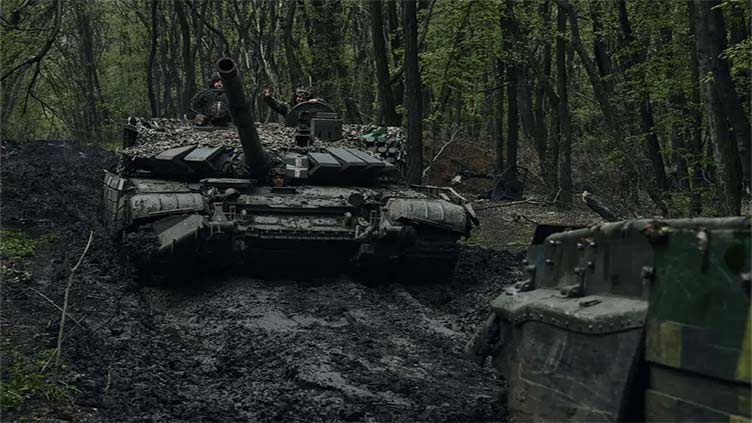Drones attack Sevastopol, crashed drone found near Moscow

World
The attack was the latest in a series of attempts on Sevastopol, the main naval base in Crimea.
KYIV, Ukraine (AP) — Russian-appointed authorities in Crimea said the military fended off a Ukrainian strike on the port of Sevastopol on Monday, while a drone was also reportedly found in a forest near Moscow — attacks that come as Ukraine is believed to be preparing for a major counteroffensive.
The Moscow-appointed head of the port city of Sevastopol in Crimea, Mikhail Razvozhayev, said the military destroyed a Ukrainian sea drone that attempted to attack the harbour in the early hours. He said another drone blew up without inflicting any damage.
The attack was the latest in a series of attempted strikes on Sevastopol, the main naval base in Crimea that Russia illegally annexed in 2014.
Ukrainian authorities didn’t immediately comment on Monday’s strikes. After previous attacks on Sevastopol and other areas, Ukrainian officials stopped short of openly claiming responsibility but emphasized the country’s right to strike any target in response to the Russian aggression.
Russian news reports also claimed on Monday that a Ukrainian exploding drone was found in a forest in a forest about 30 kilometers (about 19 miles) east of the Russian capital.
While it didn’t explode, the incident again underscored Ukraine’s capability to reach deep inside Russia as the Ukrainian military is thought to be preparing for a spring counteroffensive to reclaim occupied areas.
Observers believe that the counteroffensive’s most likely target would be the Russian-held parts of the southern Kherson and Zaporizhzhia regions. If the push is successful, it would allow Ukraine to cut the land corridor between Russia and Crimea.
In what could be preparations for such a move, Ukrainian forces have recently established a foothold near the town of Oleshky on the eastern bank of the Dnieper River, according to the Institute for the Study of War, a Washington-based think tank.
Ukraine has recently received sophisticated weapons from its Western allies, and new troops freshly trained in the West, giving rise to growing anticipation of an offensive.
American-made Patriot missiles arrived in Ukraine last week and military spokesman Yuriy Ihnat said Sunday on Ukrainian television that some have already gone into service.
The Russian forces, meanwhile, have continued their nearly nine-month effort to capture the Ukrainian stronghold of Bakhmut in the eastern Donetsk region.
Ukrainian President Volodymyr Zelenskyy emphasized the importance of defending Bakhmut in last month’s interview with The Associated Press, saying that its fall could allow Russia to rally international support for a deal that might require Kyiv to make unacceptable compromises.
Ukraine and Russia both have described the fighting for Bakhmut, the war’s longest battle, as key to exhausting enemy forces and preventing them from pressing attacks elsewhere along the 1,000-kilometer (620-mile) front line.
On Monday, Yevgeny Prigozhin, the millionaire owner of the Wagner Group military contractor that has spearheaded the Russian offensive in Bakhmut, claimed that Ukrainian forces have been pushed into a two-square-kilometer (less than one square mile) western section of the city. His claim couldn’t be independently verified.
“Our task is to grind the Ukrainian army down and prevent it from mounting a counteroffensive,” Prigozhin said.
Russian military bloggers speculated that a Ukrainian counteroffensive could be accompanied by a slew of drone attacks on broad areas.
Russian media identified the drone that fell near Moscow as a Ukrainian-made UJ-22 Airborne. They said it was found Sunday by a local resident. The reports alleged that the drone crashed after running out of fuel or hitting a tree. They said it carried 17 kilograms (37 pounds) of explosives.
The UJ-22 is a small reconnaissance drone that can carry about 20 kilograms (44 pounds) of explosives and has a range of autonomous flight of up to 800 kilometers (about 500 miles).
Last month, another drone that the authorities suspected also came from Ukraine was found in Shchelkovo, about 15 kilometers northeast of Moscow, although it didn’t carry explosives.
Also in March, a heavy Ukrainian Tu-141 Strizh jet-powered drone exploded in the city of Kireyevsk in the Tula region about 200 kilometers east of Moscow, injuring three, leaving a big crater and damaging several buildings. The Russian Defense Ministry said the drone was brought down by air defenses.
Russian authorities have said that Ukraine has used the Soviet-made Tu-141 drones that have a range of about 1,000 kilometers to strike facilities in Russia. In December, such drones hit two Russian air bases for long-range, nuclear-capable bombers. The Russian Defense Ministry said the drones were shot down, but it acknowledged that the debris damaged some aircraft and killed several servicemen.
In February, the authorities also reported that a Ukrainian drone was found in a forest near Gubastovo in the Kolomna region, about 80 kilometers southeast of Moscow. The drone fell close to a major natural gas pumping facility, its apparent target.
Another drone exploded in February in a forest near Kaluga, about 150 kilometers southeast of Moscow, hurting no one.
Ukraine’s presidential office said Monday that at least four civilians were killed and 13 others wounded by the latest Russian attacks over the previous 24 hours. Two people were killed in Bakhmut and two others in the southern city of Kherson.


